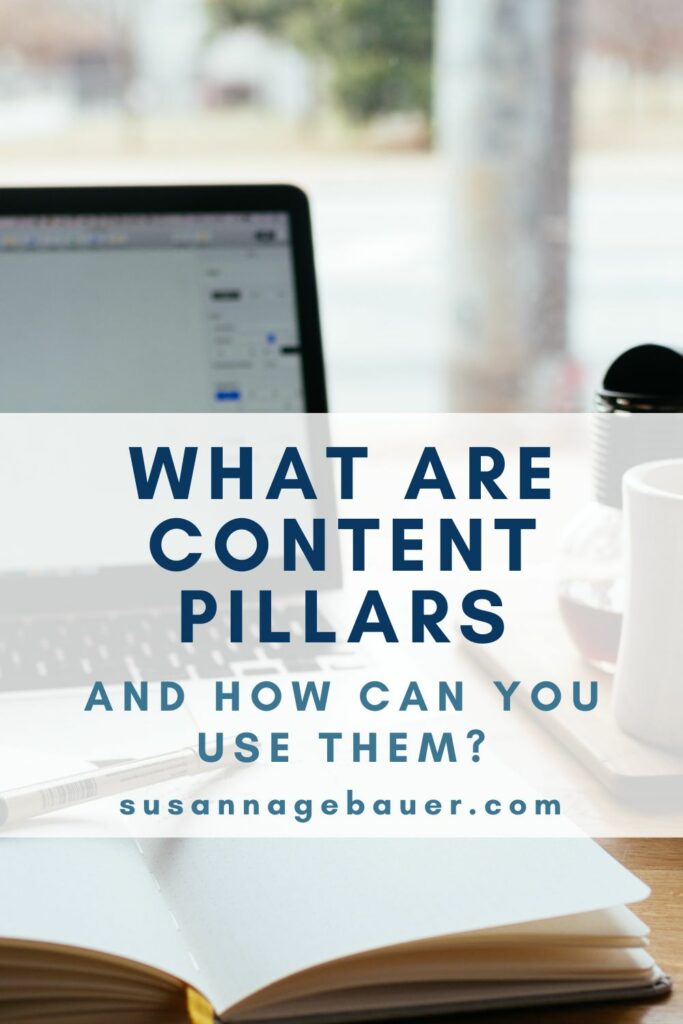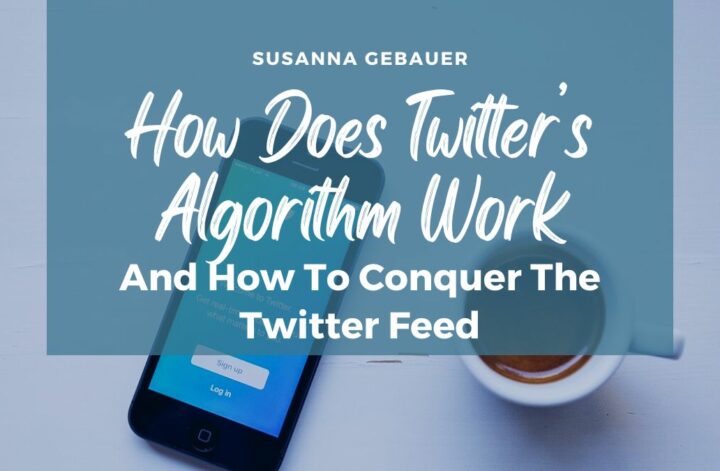Many content creators and content marketers struggle to create enough content. The solution could be to make your content creation more strategic. Every piece of content has its rightful place in the collection of content on your blog. This way, every piece of content would contribute to the marketing power of your blog or website. The answer is content pillars.
I like to create content with a clear purpose. Sure, I have an overall goal for my content marketing strategy, but I like a purpose for each piece of content I create.
Something like “This piece of content is supposed to earn me social media shares.” “That piece of content should bring in some signups to my email list.” “And maybe this piece of content with this keyword could drive some traffic from Google search.”
That is what content pillars and content clusters around them do for me:
They give each piece of content a purpose. The content pillars contribute to my branding and authority on chosen topics. Each piece of cluster content contributes to the power of my pillar content and the pillar content can boost highly targeted signups and conversions.
Learn more about content creation and how content pillars fit into the complete content creation workflow in this extensive guide:
What are content pillars?
With content marketing, you are usually trying to brand yourself or your company as the expert in a chosen field. Your content needs to show precisely which field you are the expert in.
This is what content pillars are about.
Example: The field of marketing is huge. And a marketing blog can cover a broad variety of topics.
But there are some marketers, who are experts in a narrower niche.
For instance, Jon Loomer is the expert on Facebook advertising. His content shows it. While he may cover some topics about making money online, being an entrepreneur, or setting up a sales funnel the main focus of his blog is Facebook. That is a content pillar. His content points straight to what he excels in: Facebook ads.
What are content pillars for social media?
Content pillars for social media follow the same idea: Make the majority of your posts around content that fits your content pillar.
But we are not just talking about (blog) content here – also the conversations you join, the accounts you connect with and more should consider your content pillar.
Choose a content pillar that you want your brand to be associated with and then make sure that all your social media activity considers this: Your brand voice, your positioning, and the aesthetics of your accounts should consider your content pillar.
How can content pillars contribute to your search traffic?
The competition for rankings in search engines is fierce. It is getting harder by the day to find keywords for which new or smaller blogs and websites can still rank high enough to earn some search traffic.
In addition, the behavior of searchers has changed. We are no longer searching for broad keywords but are used to typing in sentence fragments as searches. This results in many slightly different searches all for one topic:
- running shoes
- buy running shoes
- where can I buy running shoes
- where to buy running shoes
- where to buy running shoes near me
- where can I buy running shoes in Berlin
- buying running shoes guide
- shop running shoes
Search algorithms are intelligent enough to make the connection between similar searches and find connections between various search queries.
You can help Google and other search engines to contextualize your content by providing more structure to your blog. And that is what content or topic clusters do.
Without content or topic clusters, your blog structure looks something like this:

In this setting, every piece of content has to fight for search rankings more or less on its own. Sometimes your content pieces will even compete against each other for similar keywords.
Content pillars can help your content to rank higher for various search phrases through added structure and context that is passed through internal links. The idea is to create several pieces of content for related topics and have all of them link to one central cornerstone content page and pass some of their link juice or ranking power AND context to that central page.
The structure of your blog using topic clusters is something like this:

What are pillar pages?
Pillar pages are the central pages in this pillar content construction, the page all other cluster pages link to.

Usually this pillar page is the one with the most amount of value for your audience and you should use this pillar page to make some form of conversion. For instance, you can offer a downloadable freebie on this pillar page in exchange for an email signup to your email list – in some cases, it might even work to sell a product directly on this pillar page.
This way a pillar page can be used to boost your email list growth (or revenues) with targeted signups for this pillar topic.
Content/topic Clusters and Pillar Pages
The cluster content around your pillar pages needs to be closely related to at least a smaller part of the content/topic on your pillar page. In many cases, the cluster pages handle one aspect of the topic of the pillar page whereas the pillar page offers a more extensive view.
Each cluster content piece should link to the pillar page for further reading or more information.
An example of a topic cluster could be something like this:
Content Pillar: Link-building tactics
Cluster Content:
- internal linking
- broken link strategy
- linkbait content and how to use it to get more links
- Guest blogging for link building – yes or no
- The skyscraper technique
- The importance of social signals for SEO
- Why some links are more valuable than others
- Why outbound links should be part of your link-building consideration
- How to utilize your competitors in your link building
- …
And a pillar page could then be “The Ultimate Guide to Link Building for New Blogs.”
How to build content clusters for your blog
There are basically two ways of building content clusters for your blog.
- Content Clusters from existing content
- Content Clusters from new content
Let’s take a look at both ways.
How to use the concept of topic clusters for existing content
If you have been blogging for a while, you probably have a large number of content pieces already published. That means you don’t have to start your content clusters from scratch. You can start with your existing content.

Sort your topics into groups. For our old blog on The Social Ms, I could start grouping my content broadly into the following topics:
- Content Marketing
- Guest Blogging
- SEO
- Social media marketing
These groups of topics are still very broad, and since we have a huge number of blog posts, I can go a step further. For Twitter, I could consider the following topics:
- Growing an audience on Twitter
- Twitter features
- Twitter marketing tactics
For each of them, there already exist numerous articles that I could use as cluster content. Let’s consider Twitter Features as a content pillar. I have written articles for the following Twitter features:
- Twitter Polls
- Twitter Feed
- Twitter Moments
- Twitter lists
- Twitter advanced search
- The Twitter scheduling feature
- …
What I am lacking is a pillar content page. I have a post about the most important Twitter features, but that is not enough for pillar content.
I could now create a pillar page “The ultimate guide to Twitter features and how to use them.” On this page, I could offer a downloadable version of the guide in exchange for an email address.
How to use the concept of topic clusters and pillar pages in your content creation?
When you are planning out your content, topics, types of content, and the results you can expect from them, the topic cluster concept can help you add structure, purpose, and strategy to your content creation.
Here is how:
First, consider what cluster content you may need to add to give your existing content clusters more power. For instance, the Twitter features could do with a blog post about Twitter Threads that I have not yet written.
Second, consider which topic clusters you want to add to your content list in the near future.
Instead of focusing on keywords or keyword groups, take a step back and consider topics, you would like to be recognized for. Because it is hard to focus on one keyword or keyphrase when you really want to get attention for all of the related searches.
Make a list of 5 – 10 topics that you want to work on. These topics should be solutions to problems your target group has on their mind.
Now, use keyword research, talk to customers and ask your social media audience what cluster topics you should cover to provide a thorough solution to the topic.
Make a list of cluster content ideas for each topic. Keep in mind that you should easily be able to find 10 – 20 (better even if you can come up with far more ideas) cluster pieces to fill up the content cluster. If you cannot come up with a minimum of 10 ideas for cluster content, maybe your topic is too narrow.
You now need to start creating the cluster content pieces. With the 5 to 10 content pillars and a long list of 20 cluster content ideas per pillar, you should be able to fill your content calendar for a couple of weeks or even months.

If you struggle to find a content pillar idea, you can use keyword research: Use a main keyword for the pillar page and create a cluster page for all the longtail keyword ideas you can find through research.
You still need to start working on your pillar page. It really is up to you when you do this. To make sure that you utilize the most important aspects of each of your cluster pieces in your pillar content, I would consider working on the pillar page once you already have created a couple of the cluster pieces.
Quote Source: Hubspot
However, if you are pressed for early results, you may want to consider creating the pillar page earlier and then update it when significant information comes up in the content creation process for the cluster content.
You now have a thorough content creation plan with a clear goal for each piece of content in your calendar. Every piece of content now fits like a glove into your overarching content marketing strategy.
That is what I love about the content pillar and cluster concept: It adds so much purpose to creating each piece of content.
Knowing WHY I create exactly this piece of content turns the endless repetition of content creation into a much more entertaining game.
Content Pillar Examples
Pillar pages come in various forms. What all of them have in common is that they aim to provide a huge amount of value to your audience – and help you convert customers in various ways.
To help you find ideas for your pillar pages, here are some ideas and concepts for pillar pages that you should consider:
x10 content pillar page
This type of pillar page aims to be 10 times more valuable than every other page on this topic that is out there.
This type of pillar page needs to be of extremely high quality, in-depth and extensive, problem-solving, use great design/look and feel and be user-friendly.
The x10 content pillar page usually tackles the main topic of your business – luring in the customers for your main product.
Example: MOZ’s Beginner’s Guide to SEO
This guide has been the go-to page for people looking for an introduction to SEO for years. And you can clearly see how it works:
Visitors to the site get the solution to their question: The guide to SEO with many subtopics and chapters. And at the same time, MOZ invites them to join them for a free 30-day trial.

The Sub-topic pillar page
This is similar to the x10 content pillar page. The difference is that the x10 page focuses on your main solution, but you can build something similar for other topics your audience is interested in as well.
An example is Hubspot’s Pillar Page for Productivity Apps.
Hubspot’s main product is its CRM but its marketing has always been much broader, covering content marketing, social media, and other online marketing topics.
This pillar page on productivity apps does not try to directly sell. Instead, you are invited to download a free guide. The topic of the guide is strongly related to the topic of the pillar page. This way the pillar page serves to grow the Hubspot email list.

The Money-Making Pillar Page
This may still be an x10 content pillar page. The difference in this example is that it does not try to sell a product but makes money through affiliate links.
The How to Start A Blog Guide by Do you even blog
The page is a couple of years old, and although the title suggests that it is from this year, it is updated frequently to keep it up to date.
The owner of the page Pete MacPherson says: “I spent over 2 years and 120 hours on this piece of content, and it has completely transformed my business!”
This page shows that a pillar page is a little (or rather a lot) more than a blog post – it looks and feels different. The user experience is different.
While you are asked to signup for his newsletter at the bottom of the page, this does not look like the main purpose of the page.
Instead, you early on learn that some links on the website are affiliate links. And I know that a “Start a blog” page with a ton of traffic can make a bunch of money from affiliate links for hosting alone.

Final words on Content Pillars

Learning about content clusters and content pillars has changed my perception of blogging and how I plan out my blog post creation.
Yes, I have always tried to provide solutions and answers to questions my audience has.
But content clusters as the foundation for content creation have brought much more focus to my choice of topics. And this new perspective on goal orientation not only influences my blog and content creation but also my social media activity.
I find topic pillars so helpful in the planning of my blog and content, now let’s see how much they can add to the success of this new blog.
Do you need help with your content marketing and blogging? Join me for a 4-day email course and learn the basics of content marketing:






3 Comments
Hi Susanna,
Found your blog via Twitter actually
I like your point about each piece of content having an objective. Shares, traffic, followers, etc.
I feel like this doesn’t get talked about enough, could be an entire article even?
In any case, great writer and very extensive!
Hi Benjamin,
Welcome to my new blog!
I absolutely agree. We should talk more about content having a purpose. Maybe it is not so important when you first start your blog. But it would have helped me to be more aware of this.
I created so much content and always felt it was not enough. But it would have been enough, had I concentrated more on the purpose of each piece of content and working on reaching the goal for each piece of content.
Just more content is not solving any problems for bloggers.
Yes, maybe I am going to create a post about this!
Best,
Susanna
Susanna these are smart blogging tips. Setting up content pillars allows bloggers to pass strong juice-influence through links. Makes perfect sense to do this to enhance your blog and to drive Google traffic. Google wants to know that your blog is an authority in a niche; show it to ’em with content pillars.
Ryan